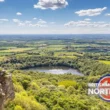The History and Heritage of Northern England.
If British National Socialists and racial Nationalists do not understand the history and heritage of their own country, then they lack the underpinning knowledge of what it is they are fighting for.
This series of articles explores the history and traditions of the important cities and towns of the North of England.
It is worth noting that place names changed over the centuries and spellings of place names in Britain were not standardised until the late 18th or early 19th Century. Often place names were written down by clerks or scribes who made the best attempt to set down a local dialect name or spell a version that could be understood nationally.
CARLISLE – Historically the most besieged city in England.
Originally called Caer Luel, or Caerleyl or Caer Liguid, (known to the Scots by the Gaelic name Cathair Lucil).
An ancient settlement at the point where three rivers flow towards the Solway Firth,the rivers Eden, Caldew and Petteril. The Celtic Britons first established the settlement on the Solway Plain and dedicated the place to their god Lugos.
A number of Celtic tribes claimed dominance over the Solway Plain and principally the northern British Brigantes ruled until the Roman occupation. However the area was often contested by the Strathclyde Britons (also known as the Strathclyde Welsh), the tribes of the Selgovai and the Novanti. Since there was no written records at this time, we rely on later Roman texts written in Latin.
The existing Celtic settlement was first recorded by the Romans occuptation army who recorded the Latinised name Luguvalium. Eventually the Romans included a series of forts in the defensive line of Hadrian’s Wall.
After the Romans the town became part of the Kingdom of Rheged from roughly 410 AD until about 600 AD.

The northern Angles took over the settlement and incorporated it under the domination of what became the Anglo-Saxon kingdom of Northumbria. During the expansion of early Christianity into northern Britain, the settlement became a centre for the early Church, Saint Cuthbert himself spent some time here. Carleyl was then ruled for Northumbria by a series of Anglian sub-kings until 876 AD when a Danish war-band attacked and burned down the town.
The town was rebuilt and ruled from Jorvik (York) by a succession of Viking kings as part of th Danelaw until the death of Eric Bloodaxe in 954 AD, after which control came under the Anglo-Saxon kings of England.
This region was frequently raided by Norse vikings, Hiberno-Norse, crossing from their outposts in Ireland, Scots and Irish war-bands from Strathclyde.Periodically Carlisle was besieged by the Scots and was frequently claimed by successive Scottish kings.
In 1092 the Normans built a timber fortress on a mound in the centre of the town, later in the 12th Century King Henry 1st rebuilt the castle in stone, forming the core of the existing castle as a bastion against the Scots.

Carlisle theoretically was an English town with authority over Cumberland, Westmorland and northern Lancashire, but this was frequently challenged by powerful families on both sides of the Border and the territory was plagued by bands of ‘Border Reivers’, armed bands of warriors loyal to local warlords.
Carlisle changed several times over the centuries between being a Northern English frontier city and being a Scottish border outpost. Carlisle finally becoming a permanent English city after the Act of Union.
Carlisle became the county town for the old county of Cumberland.
This historic town was eventually reclassified during local government reorganisation in 1970, when under Whitehall diktat the ancient counties were merged into what is now Cumbria.

Resources:
Hadrians Wall: Hadrians Velella, Public domain, via Wikimedia Commons.
Carlisle Castle: Neil Boothman from Carlisle, United Kingdom, CC BY 2.0 https://creativecommons.org/licenses/by/2.0, via Wikimedia Commons.
Drawing of castle: National Library of Scotland, Public domain, via Wikimedia Commons.
The British Movement welcomes articles for possible inclusion on this site from members and supporters across the North of England. Please remember that we have to operate within the laws of this country – we will not include any content that is against the current laws of the United Kingdom. News reports should be topical and be relevant to the regions covered by this website.













Perfectly situated geographically for us to start our own ‘Northwest Front’ just like in America. Hail Victory good Folk \o